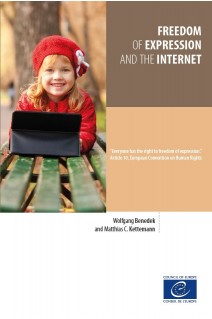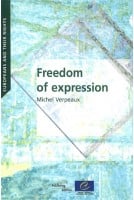



With the rise of the Internet, the opportunities to express oneself have grown exponentially, as have the challenges to freedom of expression. From the Arab Spring to the global Occupy movement, freedom of expression on the Internet has had a profound impact on the debates which shape our future. At the same time, an increasing number of states use the Internet to spy on journalists and citizens, to prosecute and jail bloggers, and to censor online information.
This book sets out to answer essential questions regarding the extent and limits of freedom of expression online. It seeks to shed light on the often obscure landscape of what we are allowed to say online and how our ideas, and the process of imparting and receiving information, are protected.
It shows the large ambit of rights protected by freedom of expression – including freedom of the media and the right to access information via the Internet. It also highlights the importance of the standard-setting, monitoring and promotion activities of international and non-governmental organisations, with a chapter on relevant national practices that illustrates how different states deal with the challenge that the Internet has brought to ensuring freedom of expression for all. As the importance of the Internet in our daily lives grows, readers will find this book to be a valuable resource for understanding the rights and obligations of each actor on the Internet, including states, Internet companies and civil society.
Contents
List of abbreviations
Table of cases
Preface
1. Introduction: the challenges of ensuring freedom of expression on the Internet
2. The content of freedom of expression online
2.1. Main elements of the right
2.1.1. Freedom of opinion
2.1.2. Freedom of information
2.1.3. Freedom of the press and the media
2.1.4. Freedom of international communication
2.1.5. Freedom of artistic expression
2.1.6. Freedom of cultural expression
2.1.7. Freedom of science
2.1.8. A new freedom? Internet freedom and openness
2.1.9. Right to anonymity
2.1.10. Right to whistle-blowing
2.2. Corollary rights: freedom of assembly and association, right to education and access to knowledge
2.3. Right to access to the Internet
3. Restrictions on freedom of expression online
3.1. Principles and problems
3.2. Criteria for restrictions and the practice of the Court in Internet cases
3.2.1. Criteria for restrictions
3.2.2. The practice of the Court
3.3. Conclusion
4. Standard-setting by the Council of Europe and non-state actors
4.1. The context: the role of human rights in Internet governance
4.2. Activities of the Council of Europe: awareness raising and tandard-setting
4.2.1. Recommendations and declarations
4.2.2. Guidelines and recommendations for business
4.3. Activities of non-state actors
4.3.1. The Charter on Human Rights and Principles for the Internet
4.3.2. Standard-setting in the private sector
4.3.3. Transparency to protect freedom of expression
5. Specific issues
5.1. Internet content regulation and freedom of expression
5.2. Access to the Internet as a precondition for freedom of expression online
5.3. Technological neutrality and freedom of expression
5.4. Network neutrality and freedom of expression
5.5. Characteristics of protected and unprotected speech online
5.6. Fighting online hate speech
5.7. Defamation, reputation and freedom of expression online
5.8. Protection of children in light of freedom of expression
5.9. Freedom of expression and Internet domain names
5.10. The role of Internet intermediaries
5.11. Freedom of expression in social networks
5.12. Private and public spaces on the Internet
5.13. Transcending the national level
6. Relevant practice on the national level
6.1. Jurisdiction and freedom of expression online
6.1.1. France v. US and Yahoo v. LICRA: a tale of two countries and two courts
6.1.2. UK: the Internet comes under national jurisdiction
6.2. Access and freedom of expression online
6.2.1. Egypt: Internet shutdowns
6.2.2 Internet access as a protected right in 20 Council of Europe member states
6.3. Copyright and freedom of expression online
6.3.1. France: the limits to enforcing copyright
6.3.2. European Union: citizen activism for freedom of expression
6.4. Public and private violations of freedom of expression online
6.4.1. United Kingdom: limits of freedom of expression online – and the limits of these limits
6.4.2. Twitter in France, Germany and the US: testing boundaries of free speech
6.4.3. United Kingdom: private censorship through hotlines
6.5. Powerful Internet companies and national laws: who wins the battle for freedom of expression?
6.5.1. Germany: regional approaches to ensuring pseudonymity
6.5.2. Google Italy: personalising (criminal) liability for online content
6.5.3. UK: publisher’s liability for Google confirmed
6.5.4. UK, Germany and the Council of Europe: whistle-blowing as a human right
6.6. Business and freedom of expression online
6.6.1. Tajikistan: no complicity of companies in censorship
6.6.2. EU: Does the export of censorship and surveillance technology violate human rights?
7. European monitoring mechanisms
7.1. Council of Europe Internet governance strategy
7.2. Monitoring by Council of Europe bodies
7.2.1. The Committee of Ministers
7.2.2. The Parliamentary Assembly
7.2.3. The Secretary General
7.2.4. The Commissioner for Human Rights
7.2.5. The European Court of Human Rights
7.2.6. The Council of Europe’s other monitoring
7.2.7. The European Committee on Social Rights
7.2.8. The Framework Convention for the Protection of National Minorities (FCNM)
7.2.9. The European Commission against Racism and Intolerance (ECRI)
7.2.10. Capacity building
7.3. Monitoring by the OSCE and the EU
7.3.1. The OSCE
7.3.2. The EU
7.4. European hotlines
7.5. Civil society watchdogs
8. Promotion of freedom of expression online
8.1. The Council of Europe
8.2. The European Union
8.3. The Organization for Security and Co-operation in Europe (OSCE)
8.4. The United Nations Educational, Scientific and Cultural Organization (UNESCO)
8.5. The UN Special Rapporteur on Freedom of Opinion and Expression
8.6. Initiatives by individual states
9. Conclusions
9.1. Freedom of expression as the key right of the Internet age
9.2. Setting standards for free speech online: the impact of the Council of Europe
9.3. Protecting Internet-based freedom of expression: a daily challenge
9.4. The corrective function of the European Court of Human Rights
9.5. Judges outside the courtroom: monitoring freedom of expression
9.6. Taking things one step further: promoting freedom of expression
9.7. Freedom of expression on the Internet: a catalyst and an enabler of human rights
Executive summary
Bibliography





With the rise of the Internet, the opportunities to express oneself have grown exponentially, as have the challenges to freedom of expression. From the Arab Spring to the global Occupy movement, freedom of expression on the Internet has had a profound impact on the debates which shape our future. At the same time, an increasing number of states use the Internet to spy on journalists and citizens, to prosecute and jail bloggers, and to censor online information.
This book sets out to answer essential questions regarding the extent and limits of freedom of expression online. It seeks to shed light on the often obscure landscape of what we are allowed to say online and how our ideas, and the process of imparting and receiving information, are protected.
It shows the large ambit of rights protected by freedom of expression – including freedom of the media and the right to access information via the Internet. It also highlights the importance of the standard-setting, monitoring and promotion activities of international and non-governmental organisations, with a chapter on relevant national practices that illustrates how different states deal with the challenge that the Internet has brought to ensuring freedom of expression for all. As the importance of the Internet in our daily lives grows, readers will find this book to be a valuable resource for understanding the rights and obligations of each actor on the Internet, including states, Internet companies and civil society.
Attention, en vertu de nos conditions générales de vente, l'achat des PDF/epub est réservé aux particuliers.
